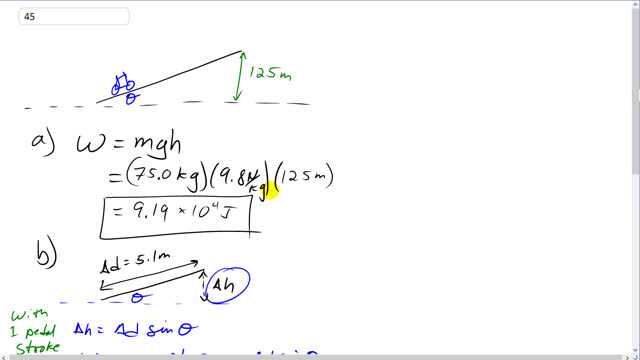
A cyclist intends to cycle up a hill whose vertical height is 125 m. The pedals turn in a circle of diameter 36.0 cm. Assuming the mass of bicycle plus person is 75.0 kg,
- calculate how much work must be done against gravity.
- If each complete revolution of the pedals moves the bike 5.10 m along its path, calculate the average force that must be exerted on the pedals tangent to their circular path.

In order to watch this solution you need to have a subscription.
This is Giancoli Answers with Mr. Dychko. The total amount of work against gravity that the cyclist has to do is their weight times the change in height. So that's 75 kilograms times 9.8 newtons per kilogram times 125 meters—vertical rise— which is 9.19 times 10 to the 4 joules. In part (b), we have to find the average force that they apply on the bicycle pedal. We can consider just one pedal stroke and we know that the work done by the pedal is gonna be the weight, mg, times the small amount of rise that happens in one pedal stroke, we'll call that delta h. And we can make an expression for delta h, in terms of, delta d and sin theta because we are given both of these pieces of information; delta d is the distance along the hypotenuse which is 5.1 meters covered in one pedal stroke, times sin of theta and we know theta is seven and a half degrees. So, we'll substitute for delta h there and I usually like to make my substitution's in red here so let's say delta h sin theta in place or delta d sin theta in place of delta h. The work done in one pedal stroke, you could also say, is equal to the tangental force applied on the pedal, which is ultimately what we want to find here multiplied by the distance over which that force is applied and that distance is the circumference of this circle and the circumference is 2πr. So, we can say then that since this equals the work done by one pedal stroke and this equals the work done in one pedal stroke, these two things are equal to each other. So we have F2πr equals mg delta d sin theta. And then we can solve this for F by dividing both sides by 2πr. And we have F then is mg delta d sin theta over 2πr. So we have 75 kilograms times 9.8 newtons per kilogram times 5.1 meters traveled in one pedal stroke times sin of 7.5 degrees— incline of the hill— divided by 2 times pi times the radius, which is 0.36 meters— diameter—divided by 2 and that gives 433 newtons, average force.
I wish you would explain why you are using the specific equations instead of just the answers